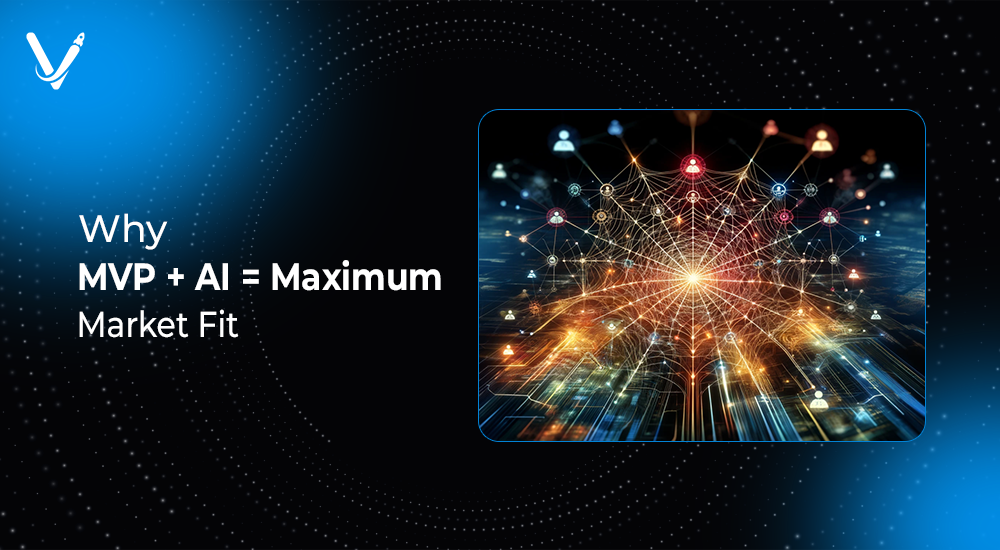Why MVP + AI = Maximum Market Fit


- Aug 14, 2025
Launching a product is no longer about luck and timing alone. In today’s digital-first economy, speed and intelligence determine who thrives and who fades into obscurity. Startups and enterprises alike are under pressure to innovate rapidly, validate ideas quickly, and adapt continuously. This is where the concept of the Minimum Viable Product (MVP) has always been a savior. But now, pair MVP with Artificial Intelligence (AI), and you get a powerful formula for maximum market fit.
This article explores why the blend of MVP and AI is revolutionizing how businesses validate ideas, reach customers, and scale. We’ll cover the fundamentals of MVP, how AI amplifies every stage of the product lifecycle, the benefits for startups and enterprises, real-world use cases, future trends, and practical strategies to adopt this approach. By the end, you’ll see why MVP + AI isn’t just a smart move—it’s the most reliable path to building products users truly want.
An MVP is not a half-baked product—it’s a strategically simplified version of your idea. It delivers just enough core functionality to solve a user’s main problem and test the waters. By launching an MVP, businesses reduce upfront investment, collect user feedback early, and iterate quickly.
The market moves too fast for companies to spend years building features no one uses. MVP ensures you test assumptions before betting everything. But with competition fiercer than ever, MVP alone is no longer enough—this is where AI enters the game.
Artificial Intelligence enhances MVP development in three fundamental ways:
Traditionally, MVP follows a loop of Build → Measure → Learn. With AI, the cycle evolves into Build → Measure → Predict → Adapt. Prediction powered by AI accelerates decision-making and gives founders confidence to pivot or double down faster.
Startups fail when they build solutions nobody wants. By embedding AI in MVPs, you can forecast demand, identify usage patterns, and validate business models more accurately.
AI-powered tools such as automated code generation, user behavior simulation, and intelligent testing drastically cut development time. This allows founders to launch MVPs in weeks instead of months.
Even in an MVP stage, AI can deliver personalized recommendations, adaptive interfaces, and contextual experiences. This creates immediate value for early adopters and boosts retention rates.
AI helps prioritize features based on predicted ROI, ensuring limited budgets and resources are invested where they matter most.
With AI-driven feedback loops, the MVP evolves naturally in sync with market trends, customer needs, and competitive shifts—leading to maximum market fit.
A digital health startup may launch an MVP app with AI-driven symptom checkers. Patients test the app, feedback validates the solution, and the AI continuously improves predictions.
MVPs in banking often use AI chatbots to handle customer queries or recommend saving strategies. Even a minimal app feels intelligent, creating early trust and adoption.
An MVP marketplace could use AI for product recommendations, even if only a few categories exist initially. Personalized discovery enhances user engagement, validating the idea quickly.
AI-driven adaptive learning in an MVP helps personalize lessons for students. Even with limited courses, the AI ensures students stay engaged, proving market demand.
Every successful MVP starts with clarity: who are you solving for and what pain are you addressing? AI tools like predictive analytics and sentiment analysis can refine this definition.
Pick the essential features and layer in AI where it makes the most impact—recommendations, automation, personalization, or predictive insights.
Use AI-powered no-code or low-code platforms, automated testing frameworks, and AI-driven design tools to accelerate development.
Launch quickly, gather user data, and let AI algorithms analyze usage patterns to guide your next iteration.
Unlike traditional MVPs, AI-enhanced MVPs don’t just evolve with manual feedback—they adapt automatically through machine learning models.
Startups gain a survival advantage by reducing burn rate, attracting early investors, and proving traction faster. MVP + AI shows not just an idea but a scalable intelligent system in action.
Enterprises avoid costly innovation failures by testing new product lines with AI-driven MVPs. This allows them to experiment with agility while maintaining brand trust.
Soon, every MVP will begin with AI at its core rather than as an add-on—automated assistants, predictive personalization, and adaptive workflows will be the new norm.
AI tools will generate wireframes, user flows, and even code, allowing non-technical founders to launch MVPs at unprecedented speed.
With reinforcement learning, products will auto-adjust their features based on real-time user interactionMVPs, closing the gap between MVP and full-fledged product instantly.
AI needs data to perform well. Early MVPs may struggle with limited datasets, requiring strategies like synthetic data or pre-trained models.
The MVP philosophy demands simplicity, while AI can introduce complexity. Balancing “just enough AI” without bloating the MVP is a fine art.
AI integration can raise costs or require specialized talent. Leveraging AI-as-a-service platforms and cloud APIs can mitigate this challenge.
The formula for product success in 2025 is clear: ensures you validate quickly, AI ensures you evolve intelligently, and together they drive maximum market fit. Businesses that embrace this model will not just survive but thrive in hyper-competitive markets.
At Vasundhara Infotech, we help startups and enterprises build AI-powered MVPs that reduce risks, validate ideas faster, and scale toward market success. If you’re ready to turn your vision into a smart, lean, and impactful product, let’s discuss how we can partner with you.
Copyright © 2025 Vasundhara Infotech. All Rights Reserved.
